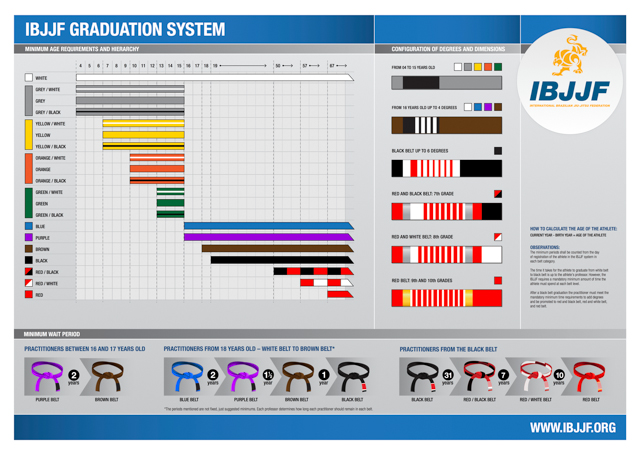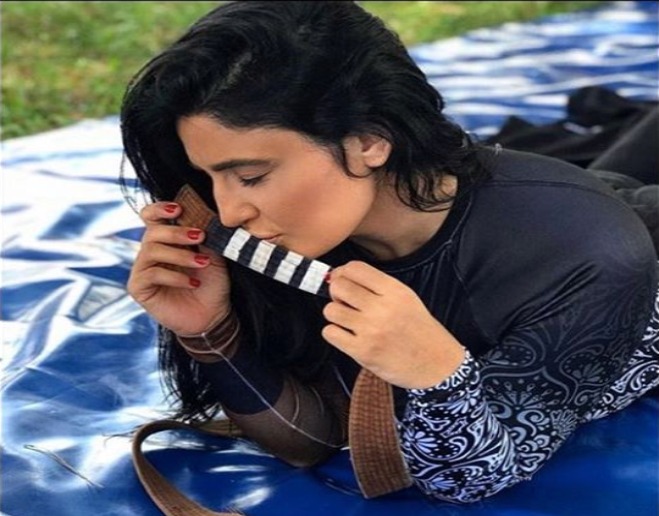Photo: @nikabjj
The belt and stripe system is the system that a coach uses to grade his students accordingly. This system is similar to the system traditional martial arts use, but very different from wrestling for instance, where there is no such grading system.

History of the belt and stripe system
The use of belts was introduced into Judo by Kano Jigoro. At the time, he was only using white and black belts, white representing beginners, black representing advanced students. Mitsuyo Maeda, the student of Kano Jigoro, arrived in Brazil in 1914, a journey which would eventually lead to the development of Brazilian Jiu Jitsu. Additional colored belts are believed to have been added in 1935 by Mikonosuke Kawaishi in Judo, a system which would later be adopted by others as well. The first official belt ranking system in Jiu Jitsu was created in 1967 by the Jiu-Jitsu Federation of Guanabara, later to be implemented by the Sport Jiu Jitsu International Federation and International Brazilian Jiu Jitsu Federation.
A look into how a student starts his path into Jiu Jitsu.
First of all, let us see how the system works in order to further understand it. Every new student that joins the academy is automatically a white belt. Assuming he is an adult, the next belt for him will be a blue belt. However before that happens, he will have to earn his stripes. Stripes are a way for the instructor to tell the student he is progressing, but he is not yet at the level required for the next belt. Generally, after you receive the 4th stripe on your belt is your last, being followed by receiving the new belt when the instructor feels you are ready. The stripe system changes at black belt level.
Belt colors and general meaning
White Belt – Every new person that steps into the academy is a white belt, regardless of his background. This belt represents the beginning of a road, lack of any technical skill and the lowest of all belts.
Blue Belt – The second belt in Brazilian Jiu Jitsu. One must be at least 16 years old in order to receive this belt. By this time the student usually has hundreds of hours spent on the mat, has developed a basic general understanding of what leverage is and how to use it and may or may not already have a set of favourite techniques which may eventually develop into a gameplan.
Purple Belt – The purple belt is the intermediary rank in Brazilian Jiu Jitsu. By this point the student is considered to have gained a large amount of knowledge and is able to use the leverage in the human body to good effect. Purple belts are generally considered good enough to assist the teachers or even teach themselves if need be. At this level students usually have a gameplan and a set of go to techniques and are working on developing different aspects of their game.
Brown Belt – The student reaches a very high level of technical understanding and is generally looked up upon by lower grading students. He has developed his gameplan to a very good level and can provide a very technical insight into certain favored techniques.
Black Belt – The black belt is the highest common belt within Brazilian Jiu Jitsu and denotes a very high level of technical, tactical and mental understanding of the sport. They are often addressed as “Professor”. If there are multiple black belts at the academy, generally the Head Coach will be addressed as Professor. At this point the stripe system changes.
Red / Black (Coral) Belt – When a Brazilian Jiu Jitsu black belt reaches seventh degree he is awarded an alternating red and black (also called Coral) belt. They are generally considered practitioners who have made a great impact into the world of Brazilian Jiu Jitsu and are often called “masters”.
Red / White Belt – Upon receiving the eighth degree, the practitioner will receive the red / white belt.
Red Belt – According to Renzo and Royler Gracie, in Brazilian Jiu Jitsu the red belt is only reserved “for those whose influence and fame takes them to the pinnacle of the art”. It is awarded in lieu of a ninth and tenth degree black belt. Red Belts are often addressed by the title of “grandmaster”.
Criterias for ranking
It has to be said that each instructor has his own criterias for giving which means that your belt rank and stripes are subjective opinion of your instructor. You might be a purple belt at some gyms, you might be a blue belt at others. Each instructor has his own set of criteria by which they grade students so you have to take that into account. Some general criterias that are taken into account for giving stripes / promotions:
Skill level. The most obvious thing that gets considered as a factor for promotion is your skill level. The better you become, the more you will be considered for receiving an extra stripe or the next belt.
Attendance. Consistency is another very important factor. Attending the sessions each week with regularity will not only help your Jiu Jitsu game, but it will help your chances to earn a promotion as well, should that be your aim.
Attitude. Being respectful, helping other students and generally having the right attitude will not only show you are a good person but it will show that you embody the spirit of martial arts.
Time spent at current belt. There is a minimum time to be spent at all belts recommended by the IBJJF but the instructors can choose to give a belt earlier than that, however the student will not be able to participate at IBJJF competitions under his new belt.
Advantages and disadvantages of this ranking system
Sandbagging
This happens when a student that is generally considered to be, let’s say purple belt level, is being left by his instructor at blue belt in order to have an advantage and win competitions at that level easier. This is generally a wide phenomenon that happens especially at Europeans and Mundials.
Not a standardized measurement method
The belt and stripe system is not standardized by any means. It is all subjective to the instructor’s opinion. He can even judge different students by different standards. What makes a blue belt deserve his next stripe? A won competition? 3 new techniques learned? These are questions that differ from instructor to instructor.
Good feedback method
There are also advantages to this. Stripes are a valuable feedback method with which the instructor can tell his student that he is progressing in training. If stripes would not be used, the duration between belts could potentially be very big, thus discouraging some students. Thus, stripes become a valuable tool with which the instructor can assess his students evolution in shorter incrementals.
Belts and stripes keep some people interested
It’s undeniable that belts and stripes can motivate people and keep them interested. If you are at least a blue belt, you will know the feeling you had when you got promoted and the excitement that followed.
Visual recognition for senior students
The belt and stripes method also gives the instructor a way to visually mark the senior students in the class room thus letting junior students know who the skilled guys are and, potentially, who they can ask for assistance when the coach is unavailable.

















